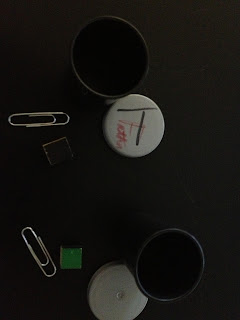When I think about the scientific method, I naturally start by listing off hypothesis, experiment, results, etc. They are listed in a very particular order and are very structured. This is how I was taught in school the scientific method worked. But, in the grand picture, the real world around us doesn't ask us a question to hypothesize on. WE have to ask the questions. Everywhere we look, there are questions to be asked, and answers to be found.
This picture above is created and adapted by Carolyn Lowe.
It is not linear. It is messy!
The MOST important thing: QUESTIONS!
 Scientists ask questions all of the time about everything. This sounds a bit like my nephews (they are 3 and 5). They ask questions about everything! About the craziest things!
Scientists ask questions all of the time about everything. This sounds a bit like my nephews (they are 3 and 5). They ask questions about everything! About the craziest things! But, somewhere along the lines.. children stop asking these questions.. Why? Where do they learn this: home & school.
It is up to teachers to encourage the questions- keep them coming! We can't tell them to stop.
For this project, Mystery Containers, we were asked to look at the container and ask as many questions about it as we could, (container shown below). As mentioned above, it is often very difficult for adults to think of endless questions about one item. Our group did pretty well! We were able to come up with 107 questions! We asked questions about the object(s) inside the container, what they were for, what were the made of, etc. And, we also asked questions about the container itself.
After asking a multitude of questions, we had to figure out, without opening, what was inside the container. How could we do that when we had so many questions about it in the first place? To help us in the process, Dr. Lowe gave us some testing materials. These materials included another film container, paper clips, pennies, tacks, small wooden blocks, magnet, etc.
The first thing we did was listen the the original containers sound. How many items did we think it contained? What did is sound like when the items hit the wall of the container? We thought that there might be paper clips in the container, because when the object(s) hit the wall of the container, it sounded light and higher pitched.
To test and see if there were paper clips in the container, we used our magnet and a paperclip from our testing materials to see how well they held together. Since the paper clip stuck so well to the magnet, we tried putting the magnet up to our original container, and then shook it, to see if there was any difference. And, low and behold, there was!
When we shook the container with the magnet outside of it, holding the paperclip, we could tell there was another item in the container that moved around. We knew that the other item was not magnetic, and seemed to be lightweight. So, we tried the small wooden block and the small plastic balls. Once we tried the small plastic ball(s), it didn't seem right. We tried rolling them around in our test container, and it was obvious that they rolled. Whereas, our original container did not sound like the second object was rolling.
So, that left us with the small wooden block. We were pretty sure that is what was in our container. But, just to be accurate, we weighed both containers- our original with unknown objects inside, and our test container with the paper clip and the small wooden block. They were nearly the same weight! So, we decided that this was our best idea as to what was inside of our mystery container.
And... we were right!

.jpeg)
.jpeg)
.jpeg)


I really like all the pictures you included!
ReplyDelete